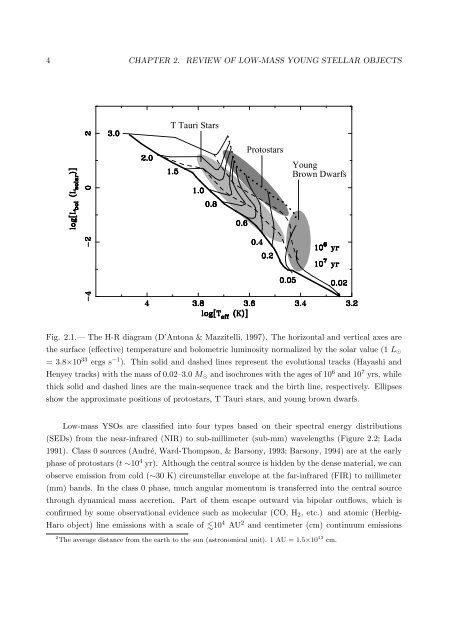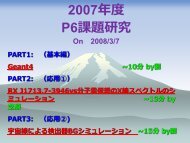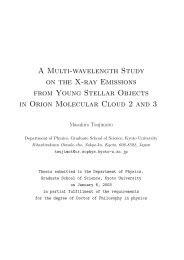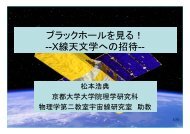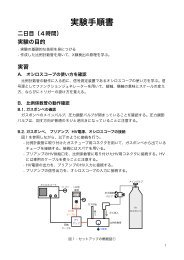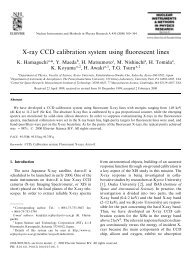X-ray Study of Low-mass Young Stellar Objects in the ρ Ophiuchi ...
X-ray Study of Low-mass Young Stellar Objects in the ρ Ophiuchi ...
X-ray Study of Low-mass Young Stellar Objects in the ρ Ophiuchi ...
You also want an ePaper? Increase the reach of your titles
YUMPU automatically turns print PDFs into web optimized ePapers that Google loves.
4 CHAPTER 2. REVIEW OF LOW-MASS YOUNG STELLAR OBJECTST Tauri StarsProtostars<strong>Young</strong>Brown DwarfsFig. 2.1.— The H-R diagram (D’Antona & Mazzitelli, 1997). The horizontal and vertical axes are<strong>the</strong> surface (effective) temperature and bolometric lum<strong>in</strong>osity normalized by <strong>the</strong> solar value (1 L ⊙= 3.8×10 33 ergs s −1 ). Th<strong>in</strong> solid and dashed l<strong>in</strong>es represent <strong>the</strong> evolutional tracks (Hayashi andHenyey tracks) with <strong>the</strong> <strong>mass</strong> <strong>of</strong> 0.02–3.0 M ⊙ and isochrones with <strong>the</strong> ages <strong>of</strong> 10 6 and 10 7 yrs, whilethick solid and dashed l<strong>in</strong>es are <strong>the</strong> ma<strong>in</strong>-sequence track and <strong>the</strong> birth l<strong>in</strong>e, respectively. Ellipsesshow <strong>the</strong> approximate positions <strong>of</strong> protostars, T Tauri stars, and young brown dwarfs.<strong>Low</strong>-<strong>mass</strong> YSOs are classified <strong>in</strong>to four types based on <strong>the</strong>ir spectral energy distributions(SEDs) from <strong>the</strong> near-<strong>in</strong>frared (NIR) to sub-millimeter (sub-mm) wavelengths (Figure 2.2; Lada1991). Class 0 sources (André, Ward-Thompson, & Barsony, 1993; Barsony, 1994) are at <strong>the</strong> earlyphase <strong>of</strong> protostars (t ∼10 4 yr). Although <strong>the</strong> central source is hidden by <strong>the</strong> dense material, we canobserve emission from cold (∼30 K) circumstellar envelope at <strong>the</strong> far-<strong>in</strong>frared (FIR) to millimeter(mm) bands. In <strong>the</strong> class 0 phase, much angular momentum is transferred <strong>in</strong>to <strong>the</strong> central sourcethrough dynamical <strong>mass</strong> accretion. Part <strong>of</strong> <strong>the</strong>m escape outward via bipolar outflows, which isconfirmed by some observational evidence such as molecular (CO, H 2 , etc.) and atomic (Herbig-Haro object) l<strong>in</strong>e emissions with a scale <strong>of</strong> 10 4 AU 2 and centimeter (cm) cont<strong>in</strong>uum emissions2 The average distance from <strong>the</strong> earth to <strong>the</strong> sun (astronomical unit). 1 AU = 1.5×10 13 cm.


